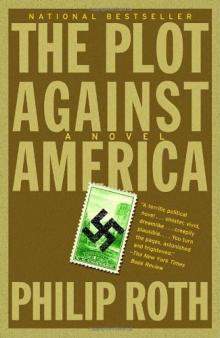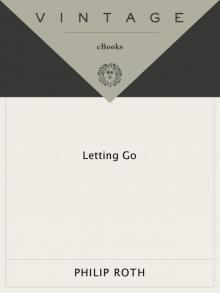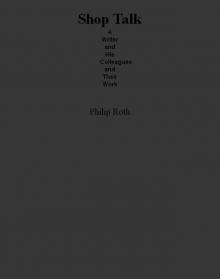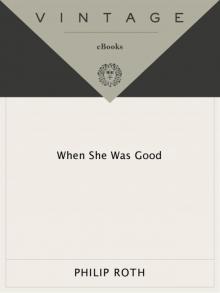- Home
- Philip Roth
The plot against America Page 7
The plot against America Read online
Page 7
Ten days later the president signed the Hawaii Understanding in Honolulu with Prince Fumimaro Konoye, premier of the Japanese imperial government, and Foreign Minister Matsuoka. As emissaries of Emperor Hirohito, the two had already signed a triple alliance with the Germans and the Italians in Berlin in September of 1940, the Japanese endorsing the "new order in Europe" established under the leadership of Italy and Germany, who in turn endorsed the "New Order in Greater East Asia" established by Japan. The three countries further pledged to support one another militarily should any of them be attacked by a nation not engaged in the European or Sino-Japanese war. Like the Iceland Understanding, the Hawaii Understanding made the United States a party in all but name to the Axis triple alliance by extending American recognition to Japan's sovereignty in East Asia and guaranteeing that the United States would not oppose Japanese expansion on the Asian continent, including annexation of the Netherlands Indies and French Indochina. Japan pledged to recognize U.S. sovereignty on its own continent, to respect the political independence of the American commonwealth of the Philippines—scheduled to be enacted in 1946—and to accept the American territories of Hawaii, Guam, and Midway as permanent U.S. possessions in the Pacific.
In the aftermath of the Understandings, Americans everywhere went about declaiming, No war, no young men fighting and dying ever again! Lindbergh can deal with Hitler, they said, Hitler respects him because he's Lindbergh. Mussolini and Hirohito respect him because he's Lindbergh. The only ones against him, the people said, are the Jews. And certainly that was true in America. All the Jews could do was worry. Our elders on the street speculated incessantly about what they would do to us and whom we could rely on to protect us and how we might protect ourselves. The younger kids like me came home from school frightened and bewildered and even in tears because of what the older boys had been telling one another about what Lindbergh had said about us to Hitler and what Hitler had said about us to Lindbergh during their meals together in Iceland. One reason my parents decided to keep to our long-laid plans to visit Washington was to convince Sandy and me—whether or not they themselves believed it—that nothing had changed other than that FDR was no longer in office. America wasn't a fascist country and wasn't going to be, regardless of what Alvin had predicted. There was a new president and a new Congress but each was bound to follow the law as set down in the Constitution. They were Republican, they were isolationist, and among them, yes, there were anti-Semites—as indeed there were among the southerners in FDR's own party—but that was a long way from their being Nazis. Besides, one had only to listen on Sunday nights to Winchell lashing out at the new president and "his friend Joe Goebbels" or hear him listing the sites under consideration by the Department of the Interior for building concentration camps—sites mainly located in Montana, the home state of Lindbergh's "national unity" vice president, the isolationist Democrat Burton K. Wheeler—to be assured of the fervor with which the new administration was being scrutinized by favorite reporters of my father's, like Winchell and Dorothy Thompson and Quentin Reynolds and William L. Shirer, and, of course, by the staff of PM. Even I now took my turn with PM when my father brought it home at night, and not just to read the comic strip Barnaby or to flip through the pages of photographs but to have in my hands documentary proof that, despite the incredible speed with which our status as Americans appeared to be altering, we were still living in a free country.
After Lindbergh was sworn into office on January 20, 1941, FDR returned with his family to their estate at Hyde Park, New York, and hadn't been seen or heard from since. Because it was as a boy in the Hyde Park house that he had first become interested in collecting stamps—when his mother, as the story went, had passed on to him her own childhood albums—I imagined him there spending all of his time arranging the hundreds of specimens that he had accumulated during his eight years in the White House. As every collector knew, no president before him had ever commissioned his postmaster general to issue so many new stamps, nor had there been another American president so intimately involved with the Post Office Department. Practically my first goal when I got my album was to accumulate all the stamps that I knew FDR had a hand in designing or had personally suggested, beginning with the 1936 three-cent Susan B. Anthony stamp commemorating the sixteenth anniversary of the women's suffrage amendment and the 1937 five-cent Virginia Dare stamp marking the birth at Roanoke three hundred and fifty years earlier of the first English child born in America. The 1934 three-cent Mother's Day stamp designed originally by FDR—and displaying in the left-hand corner the legend "In Memory and in Honor of the Mothers of America" and to the right of center the artist Whistler's celebrated portrait of his mother—was given to me in a block of four by my own mother to help get my collection going. She'd also contributed to my purchasing the seven commemorative stamps Roosevelt had approved in his first year as president, which I wanted because prominently displayed on five of them was "1933," the year I was born.
Before we went to Washington, I asked permission to take my stamp album on the trip. Out of fear that I would lose it and be heartbroken afterward, my mother at first said no but then allowed herself to be won over when I insisted on the necessity of at least having with me my president stamps—the sixteen, that is, that I owned of the 1938 set that progressed sequentially and by denomination from George Washington to Calvin Coolidge. The 1922 Arlington National Cemetery stamp and the 1923 Lincoln Memorial and Capitol Buildings stamps were far too expensive for my budget, but I nonetheless offered as another reason for taking my collection along that the three famous sites were clearly pictured in black and white on the album page reserved for them. In fact, I was afraid to leave the album at home in our empty flat because of the nightmare I'd had, afraid that either because I'd done nothing about removing the ten-cent Lindbergh airmail stamp from my collection or because Sandy had lied to our parents and his Lindbergh drawings remained intact under his bed—or because of the one filial betrayal conspiring with the other—a malignant transformation would occur in my absence, causing my unguarded Washingtons to turn into Hitlers, and swastikas to be imprinted on my National Parks.
Immediately upon entering Washington, we made a wrong turn in the heavy traffic, and while my mother was trying to read the road map and direct my father to our hotel, there appeared before us the biggest white thing I had ever seen. Atop an incline at the end of the street stood the U.S. Capitol, the broad stairs sweeping upward to the colonnade and capped by the elaborate three-tiered dome. Inadvertently, we had driven right to the very heart of American history, and whether we knew it in so many words, it was American history, delineated in its most inspirational form, that we were counting on to protect us against Lindbergh.
"Look!" my mother said, turning to Sandy and me in the back seat. "Isn't it thrilling?"
The answer, of course, was yes, but Sandy appeared to have fallen into a patriotic stupor, and I took my cue from him and let silence register my awe as well.
Just then a motorcycle policeman pulled alongside us. "What's up, Jersey?" he called through the open window.
"We're looking for our hotel," answered my father. "What's it called, Bess?"
My mother, enthralled only a moment earlier by the dwarfing majesty of the Capitol, immediately went pale, and her voice was so feeble when she tried to speak that she couldn't be heard above the traffic.
"Gotta get you folks out of here," the cop shouted. "Speak up, missus."
"The Douglas Hotel!" It was my brother eagerly calling out to him and trying to get a good look at the motorcycle. "On K Street, Officer."
"Attaboy," and he raised his arm in the air, signaling the cars behind us to stop and for ours to follow him as he made a U-turn and started in the opposite direction up Pennsylvania Avenue.
Laughing, my father said, "We're getting the royal treatment."
"But how do you know where he's taking us?" my mother asked. "Herman, what's happening?"
With the cop out front, we were
headed past one big federal building after another when Sandy excitedly pointed toward a rolling lawn just to our left. "Up there!" he shouted. "The White House!" whereupon my mother began to cry.
"It isn't," she tried to explain just before we reached the hotel and the cop waved goodbye and roared away, "it isn't like living in a normal country anymore. I'm terribly sorry, children—please forgive me." But then she began to cry again.
In a little room at the rear of the Douglas there was a double bed for my parents and cots for my brother and me, and no sooner had my father tipped the bellhop who'd unlocked our door and set our bags down inside the room than our mother was her old self—or pretended as much by arranging the contents of our suitcases in the dresser and noting appreciatively that the drawers were freshly laid with lining paper.
We'd been on the road since leaving home at four in the morning and it was after one in the afternoon when we got back down to the street to look for a place to have lunch. The car was parked across from the hotel, and standing beside it was a sharp-faced little man in a double-breasted gray suit who doffed his hat and said, "My name is Taylor, folks. I am a professional guide to the nation's capital. If you don't want to be wasting time, you might want to hire someone like me. I'll drive for you so you don't get lost, I'll take you to the sights, tell you all there is to know, I'll wait and pick you up, I'll make sure you eat where the price is right and the food is tasty, and all it will cost, using your own automobile, is nine dollars a day. Here's my authorization," he said, and he unfolded a document of several pages to show to my father. "Issued by the Chamber of Commerce," he explained. "Verlin M. Taylor, sir, official D.C. guide since 1937. January 5, 1937, to be exact—the very day the Seventy-fifth U.S. Congress convened."
The two shook hands, and in his insurance man's best businesslike manner my father flipped through the guide's papers before handing them back to him. "Looks good to me," my father said, "but I don't think nine bucks a day is in the cards, Mr. Taylor, not for this family anyway."
"I appreciate that. But on your own, sir, you doing the driving and not knowing your way around and then trying to find a parking space in this city—well, you and the family won't see a half of what you'll be able to see with me, and you won't enjoy it anywhere near as much either. Why, I could drive you to a nice place to have your lunch, wait for you with the car, and then we can start right off with the Washington Monument. After that, down the Mall to the Lincoln Memorial. Washington and Lincoln. Our two greatest presidents—that's how I always like to begin. You know that Washington never did live in Washington. President Washington chose the site, he signed the bill making it the permanent seat of the government, but it was his successor, John Adams, who was the first president to move into the White House in 1800. November 1, to be exact. His wife, Abigail, joined him there two weeks later. Among the many interesting curios in the White House, there is still a celery glass owned by John and Abigail Adams."
"Well, that's something that I did not know," my father replied, "but let me take this up with my wife." Quietly he asked her, "Can we afford this? He sure knows his oats." Our mother whispered, "But who sent him? How did he spot our car?" "That's his job, Bess—to find who's the tourists. That's how the man makes a living." My brother and I were huddled up beside them, hoping our mother would shut up and that the easy-talking guide with the pointy face and the short legs would be hired for the duration.
"What do you want?" my father said, turning to Sandy and me.
"Well, if it costs too much. . .," Sandy began.
"Forget the cost," my father replied. "Do you like this guy or not?"
"He's a character, Dad," Sandy whispered. "He looks like one of those duck decoys. I like when he says 'to be exact.'"
"Bess," my father said, "the man is a bona fide guide to Washington, D.C. Don't believe he's ever cracked a smile but he's an alert little guy and he couldn't be more polite. Let me see if he'll take seven bucks." Here he stepped away from us, walked up to the guide, they spoke seriously for a few minutes and then, the deal struck, the two again shook hands, and my father said aloud, "Okay, let's eat!" as always teeming with energy even when there was nothing to do.
It was hard to say what was most unbelievable: my being out of New Jersey for the first time in my life, my being three hundred miles from home in the nation's capital, or our family's being chauffeured in our own automobile by a stranger called by the same surname as the twelfth president of the United States, whose profile adorned the twelve-cent red-violet stamp in the album in my lap, hinged between the blue eleven-cent Polk and the green thirteen-cent Fillmore.
"Washington," Mr. Taylor was telling us, "is divided into four sections: northwest, northeast, southeast, and southwest. With some few exceptions, the streets running north and south are numbered and the streets running east and west are lettered. Of all the existing capitals in the Western world, this city alone was developed solely to provide a home for the national government. That is what makes it different not only from London and Paris but from our own New York and Chicago."
"Did you hear that?" my father asked, looking over his shoulder at Sandy and me. "Did you hear that, Bess, what Mr. Taylor said about why Washington is so special?"
"Yes," she said, and took my hand in hers to assure herself by assuring me that everything was now going to be all right. But I had only my one concern from the time we entered Washington until we left—preserving my stamp collection from harm.
The cafeteria where Mr. Taylor dropped us off was clean and cheap and the food as good as he'd said it would be, and when we finished our meal and headed for the street, there was our car pulling up to double-park out front. "What timing!" my father cried.
"Over the years," Mr. Taylor said, "you learn to estimate how long it takes a family to eat their lunch. Was that okay, Mrs. Roth?" he asked our mother. "Everything to your taste?"
"Very nice, thank you."
"So's everybody ready for the Washington Monument," he said, and off we drove. "You know, of course, who the monument commemorates—our first president, and in the opinion of most, our best president alongside President Lincoln."
"I'd include FDR in that list, you know. A great man, and the people of this country turned him out of office," my father said. "And just look what we got instead."
Mr. Taylor listened courteously but offered no response. "Now," he resumed, "you've all seen photos of the Washington Monument. But they don't always communicate just how impressive it is. At five hundred fifty-five feet, five and one-eighth inches above ground, it is the tallest masonry structure in the world. The new electric elevator will carry you to the top in one and a quarter minutes. Otherwise you can take a winding staircase of eight hundred and ninety-three steps to the top by foot. The view from up there has a radius of some fifteen to twenty miles. It's worth a look. There—see it?" he said. "Straight ahead."
Minutes later Mr. Taylor found a parking spot on the monument grounds and, when we left the car, trotted bandy-legged alongside us, explaining, "The monument was cleaned just a few years back for the first time. Just imagine that for a cleaning job, Mrs. Roth. They used water mixed with sand and steel-bristled brushes. Took five months and cost a hundred thousand dollars."
"Under FDR?" my father asked.
"I believe so, yes."
"And do people know?" my father asked. "Do people care? No. They want an airmail pilot running the country instead. And that's not the worst of it."
Mr. Taylor remained outside while we entered the monument. At the elevator, our mother, who again had taken hold of my hand, drew close to our father and whispered, "You mustn't talk like that."
"Like what?"
"About Lindbergh."
"That? That's just expressing my opinion."
"But you don't know who this man is."
"I sure do. He's an authorized guide with the documents to prove it. This is the Washington Monument, Bess, and you're telling me to keep my thoughts to myself as though
the Washington Monument is situated in Berlin."
His speaking so bluntly distressed her even more, especially as the others waiting for the elevator could overhear our conversation. Turning to another of the fathers, who was standing alongside his wife and two kids, my father asked him, "Where you folks from? We're from Jersey." "Maine," the man replied. "Hear that?" my father said to my brother and me. Altogether some twenty children and adults entered the elevator, filling it up about halfway, and as the car rose through the housing of iron pillars, my father used the minute and a quarter it took to get to the top to ask the remaining families where each was from.
Mr. Taylor was waiting outside when we finished our tour. He asked Sandy and me to describe what we'd seen from the windows five hundred feet up and then he guided us on a quick walking tour around the exterior of the monument, recounting the fitful history of its construction. Next he took some pictures of the family with our Brownie box camera; then my father, over Mr. Taylor's objections, insisted on taking a picture of him with my mother, Sandy, and me with the Washington Monument as the background, and finally we got into our car and, with Mr. Taylor again at the wheel, started down the Mall for the Lincoln Memorial.
This time, while he parked, Mr. Taylor warned us that the Lincoln Memorial was like no other edifice anywhere in the world and that we should prepare ourselves to be overwhelmed. Then he accompanied us from the parking area to the great pillared building with the wide marble stairs that led us up past the columns to the hall's interior and the raised statue of Lincoln in his capacious throne of thrones, the sculpted face looking to me like the most hallowed possible amalgamation—the face of God and the face of America all in one.

 American Pastoral
American Pastoral The plot against America
The plot against America The Human Stain
The Human Stain Nemesis n-4
Nemesis n-4 Sabbath’s Theater
Sabbath’s Theater The Professor of Desire
The Professor of Desire Our Gang
Our Gang The Breast
The Breast Operation Shylock
Operation Shylock The Dying Animal
The Dying Animal Letting Go
Letting Go The Counterlife
The Counterlife Everyman
Everyman Nemesis
Nemesis Exit Ghost
Exit Ghost Portnoy's Complaint
Portnoy's Complaint My Life as a Man
My Life as a Man I Married a Communist
I Married a Communist The Anatomy Lesson
The Anatomy Lesson The Great American Novel
The Great American Novel Shop Talk
Shop Talk The Humbling
The Humbling Zuckerman Unbound
Zuckerman Unbound When She Was Good
When She Was Good The Prague Orgy
The Prague Orgy American Pastoral (Nathan Zuckerman)
American Pastoral (Nathan Zuckerman) Goodbye, Columbus
Goodbye, Columbus Reading Myself and Others
Reading Myself and Others